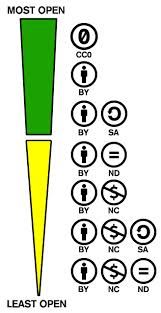
by wikipedia.org
What is Creative Commons Licence?
If you are in Internet Marketing you will have come across the phrase Public Domain. There are many pages devoted to this aspect of creating content even generating products. I will be addressing Public Domain projects in another article on this site.
What I would like to talk to you about is another way to generate content for articles or a product. Have you heard about Creative Commons Licence?
There are varying levels of licence which are determined by the creator of the work at inception.
Extract from Creative Commons Website
Attribution CC BY
This license lets others distribute, remix, tweak, and build upon your work, even commercially, as long as they credit you for the original creation. This is the most accommodating of licenses offered. Recommended for maximum dissemination and use of licensed materials.
Attribution-ShareAlike CC BY-SA
This license lets others remix, tweak, and build upon your work even for commercial purposes, as long as they credit you and license their new creations under the identical terms. This license is often compared to “copyleft†free and open source software licenses. All new works based on yours will carry the same license, so any derivatives will also allow commercial use. This is the license used by Wikipedia, and is recommended for materials that would benefit from incorporating content from Wikipedia and similarly licensed projects.
Attribution-NoDerivs CC BY-ND
This license allows for redistribution, commercial and non-commercial, as long as it is passed along unchanged and in whole, with credit to you.
Attribution-NonCommercial CC BY-NC
This license lets others remix, tweak, and build upon your work non-commercially, and although their new works must also acknowledge you and be non-commercial, they don’t have to license their derivative works on the same terms.
A piece of work that is under a Creative Commons CC-BY Licence is a signal to you that you can use the work even for a commercial purpose as long as you credit the work to the original creator. Under this licence you can even change it. These works are still under copywrite to the creator but you have alicence to use them. Unlike Copyright which excludes and restrict you from doing anything with the work and then has exceptions to the copyright. Creative Commons Licence is just the opposite it sets out you can do anything with the work and then sets of limitations to what you can do by different classes of licence.
Under Creative Commons Licence (CCL) you can share the content, under your own terms. The content you create, must adhere to the identical terms the CCL dictates.
Let me explain what happens. An author creates a piece of work. Rather than placing it under copyright, they determine what level of freedom you have to use the work, even to change their work.
A CCL is a simple way to allow other users to share; remix; and re-use the work. You can even make money from their work under the terms of the appropriate CCL. The licence is irrevocable. This means if you use content under the terms of the CCL and the author changes the terms for whatever reason, the original CCL terms still covers your rights.
An author can licence their product under different levels of CCL and the user must obey the terms of the CCL.
All CC Licences are only applicable to copyright-protected works. Copyright can cover such things as dramatic and artistic works. Including all written or displayed material to anything online, web-sites and computer programmes.
Copyright belongs to the original creator of the work. They hold all rights as the creator of the work and can object to any copying or changing of copies of the work.
International conventions cover commons licence in most countries subject to national laws.
For example with regard to copyright in the UK please see
UK Copyright Law fact sheet from the UK Copyright Service.
Seeing that work has a Creative Commons Licence is not an open door to use it any way that you wish. CCL has a variety of variations of the licence as shown above.
All work must carry an attribution to the original author of the work which is a rule. If you use work under CCL you must give proper credit to the works’ original creator. If you use images you state the name of the author and a link back to the original site that displayed the image (e.g. Pixabay.com)
Where to find creative commons licence content
The first place to try is the Creative Commons site. Here you enter your keyword and select from one of the many places detailed on the page, some may be broken links as of writing this article.
If you want music for your website try audionautix or pearltrees
Usually for images I use Google images, using http://www.google.com/advanced_image_search and always selecting ‘free to use, share or modify, even commercially’, even though I may just use the original image without change.
Info.co.uk is another good place to start your research.
Just remember everything that appears on the web is not available for your free use. For example with this website I hold copyright. It contains original information except where stated otherwise and cannot be copied or developed in any way without my express permission.
This is especially true for images. I see many instances where someone has lifted an image they like from another website. You cannot do this without permission from the web site owner. Even taking images from Google; Flickr; Pixabay, etc; is illegal. Unless they show a Creative Commons Licence, then you must adhere to the limitations of the type of licence covering the image.
Of course you can use anything that is in the Public Domain, well not quite, but that is the subject of another article on the web site.
I hope you appreciate what a valuable resource you have in looking for the symbols that say Creative Commons Licence.
